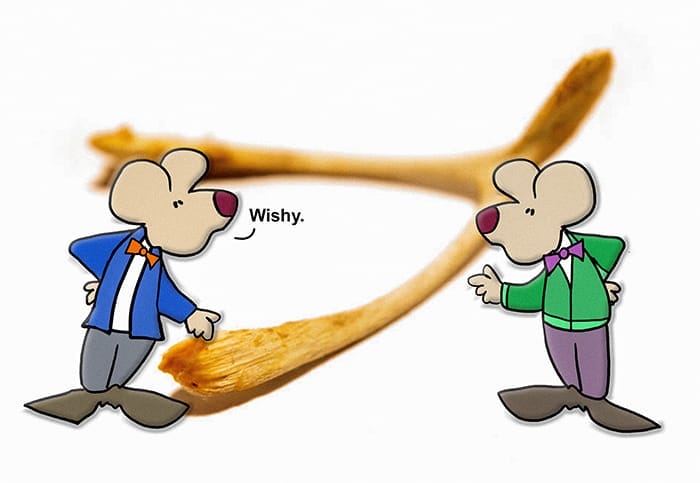Wishes. We all have them. We’ve all made them.
We’ve all blown out the candles on the birthday cake after making a good one. Or have thrown a penny into the fountain or down the well. In the summertime, we’ve blown on those dandelion seeds and watched them float away. At nighttime, there are those shooting stars.
But once a year, we bake the bird.
And there inside, as we are stripping the meat from the carcass, we find it.
The Wishbone.
What a name for a bone. But you see, wishbones have long served as a symbol of luck.
We all know the scenario. Two family members gearing up to pull the wishbone in two, hoping to come away with the bigger part.
But how did all of this start?
Well, that “wishbone” is actually the furcula. It is found in a turkey, duck, or chicken. The bone is the fusion of the bird’s clavicles right above the sternum.
But. The origins of wishbones as lucky charms go all the way back to ancient times. Long ago, ancient times.
Around 700 BCE, the Etruscans believed birds were oracles that could tell the future.
Sidebar for those who don’t know. Because I did not. The Etruscans were an ancient civilization that flourished in central Italy, primarily in the region known as Etruria. Today, that area corresponds roughly to modern Tuscany, western Umbria, and northern Lazio. These Italian people were prominent from around the 8th century BCE until they were assimilated into the Roman Republic in the 4th century BCE. So there they were. With their Italian Bird Oracles.
Anyway. Whenever the Etruscans slaughtered a chicken, they would leave the furcula in the sun to dry out. Once it was preserved, the people had hopes of gaining some of its divining powers. So the villagers would swing on by the center of town, where the dried bone sat. They’d pick up the furcula and gently stroke it while making a wish, giving it its more common name: the wishbone. Ta-Da.
Legend has it that the Romans then picked up on this superstition. Which makes sense since the Etruscans were assimilated into the Roman culture. However, by the Roman times, chickens were scarce, and therefore, so were the wishbones. People had to resort to cracking the bones in half so there were enough to go around. Spreading the luck.
Later, the Romans passed the wishbone-cracking tradition to the British, who then carried it over with them to our good old America. Home of the free, and the turkeys. Yes. As this new land was abundant with wild turkeys, people began using turkey wishbones for luck.
Just for the record, there are certain rules around cracking a wishbone. Typically, you dry the wishbone for a few days until it’s brittle — otherwise, you will have a hard time cracking it correctly. When it’s ready, two people hook their pinkie fingers around each end, make a wish and pull. Whoever ends up with the bigger piece will have their wish come true.
There have been more complicated rules throughout history, but this one prevailed.
It seems, though, that the unbroken wishbone is only the promise of good luck. It must be broken for your wish to come true — which, by the way, might be the origin of the phrase “getting your lucky break.”
So. When you wish upon a star…
Disney probably should have written a song about wishing on the wishbone.
But the only rhyme I can think of with Wishbone is Fish Phone.
And for the record. Humans have clavicles but no wishbones. Although, I sure do know a lot of humans who are turkeys.
“””””””””
“Make a wish and do as dreamers do, and all our wishes will come true.” – Cinderella (from Disney’s Cinderella)
“””””””””
“You are never too old to set another goal or to dream a new dream.” – C.S. Lewis
“””””””””
“Everything you can imagine is real.” – Pablo Picasso
“””””””””
Wish it. Crack it. Just like magic.
